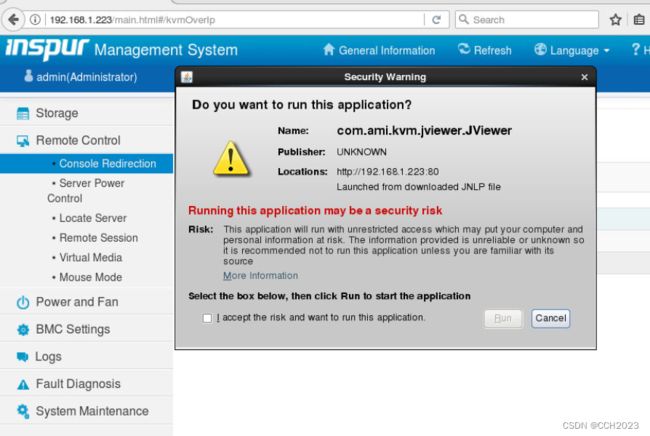运维监控学习笔记1
1、监控对象:
1、监控对象的理解;CPU是怎么工作的;
2、监控对象的指标:CPU使用率;上下文切换;
3、确定性能基准线:CPU负载多少才算高;
2、监控范围:
1、硬件监控:服务器的硬件故障
2、操作系统监控:CPU、内存、IO、进程等
3、应用服务监控:
4、业务角度进行监控
3、硬件监控:
远程控制卡:DELL服务器iDRAC、惠普服务器ILO、IBM服务器:IMM、浪潮服务器:
IPMI:智能平台管理接口(IPMI):是一种开放标准的硬件管理接口规范,定义了嵌入式管理子系统进行通信的特定方法。IPMI通过基板管理控制(BMC)(位于IPMI规格的硬件上)进行交流。使用低级硬件智能管理而不使用操作系统进行管理。
具有两个主要的特点:此配置允许进行带外服务器管理;操作系统不必负担传输系统状态数据的任务。IPMI的核心是一个专用芯片控制器(叫做服务器处理器或基板管理控制器(BMC)),其不依赖于服务器的处理器、BIOS或操作系统来工作,可谓非常独立,是一个单独在系统内运行的无代理管理子系统。
IPMI的功能:
监控服务器的物理健康特征:如温度、电压、风扇工作状态、电源状态等。
可以通过串口、Modem以及Lan等远程环境管理服务器系统、如远程开关机。
ipmitool:监控控制。
1)硬件要支持;
2)操作系统:Linux IPMI
3)管理工具:ipmitool
4、安装OpenIMPI和ipmitool:
[root@vm1 ~]# yum install -y OpenIPMI ipmitool
启动ipmi:
[root@vm1 ~]# systemctl start ipmi
使用IPMI有两种方式:1 本地调用 2 远程调用
[root@vm1 ~]# ipmitool -help
ipmitool version 1.8.18
usage: ipmitool [options...]
-h This help
-V Show version information
-v Verbose (can use multiple times)
-c Display output in comma separated format
-d N Specify a /dev/ipmiN device to use (default=0)
-I intf Interface to use
-H hostname Remote host name for LAN interface
-p port Remote RMCP port [default=623]
-U username Remote session username
-f file Read remote session password from file
-z size Change Size of Communication Channel (OEM)
-S sdr Use local file for remote SDR cache
-D tty:b[:s] Specify the serial device, baud rate to use
and, optionally, specify that interface is the system one
-4 Use only IPv4
-6 Use only IPv6
-a Prompt for remote password
-Y Prompt for the Kg key for IPMIv2 authentication
-e char Set SOL escape character
-C ciphersuite Cipher suite to be used by lanplus interface
-k key Use Kg key for IPMIv2 authentication
-y hex_key Use hexadecimal-encoded Kg key for IPMIv2 authentication
-L level Remote session privilege level [default=ADMINISTRATOR]
Append a '+' to use name/privilege lookup in RAKP1
-A authtype Force use of auth type NONE, PASSWORD, MD2, MD5 or OEM
-P password Remote session password
-E Read password from IPMI_PASSWORD environment variable
-K Read kgkey from IPMI_KGKEY environment variable
-m address Set local IPMB address
-b channel Set destination channel for bridged request
-t address Bridge request to remote target address
-B channel Set transit channel for bridged request (dual bridge)
-T address Set transit address for bridge request (dual bridge)
-l lun Set destination lun for raw commands
-o oemtype Setup for OEM (use 'list' to see available OEM types)
-O seloem Use file for OEM SEL event descriptions
-N seconds Specify timeout for lan [default=2] / lanplus [default=1] interface
-R retry Set the number of retries for lan/lanplus interface [default=4]
Interfaces:
open Linux OpenIPMI Interface [default]
imb Intel IMB Interface
lan IPMI v1.5 LAN Interface
lanplus IPMI v2.0 RMCP+ LAN Interface
serial-terminal Serial Interface, Terminal Mode
serial-basic Serial Interface, Basic Mode
usb IPMI USB Interface(OEM Interface for AMI Devices)
Commands:
raw Send a RAW IPMI request and print response
i2c Send an I2C Master Write-Read command and print response
spd Print SPD info from remote I2C device
lan Configure LAN Channels
chassis Get chassis status and set power state
power Shortcut to chassis power commands
event Send pre-defined events to MC
mc Management Controller status and global enables
sdr Print Sensor Data Repository entries and readings
sensor Print detailed sensor information
fru Print built-in FRU and scan SDR for FRU locators
gendev Read/Write Device associated with Generic Device locators sdr
sel Print System Event Log (SEL)
pef Configure Platform Event Filtering (PEF)
sol Configure and connect IPMIv2.0 Serial-over-LAN
tsol Configure and connect with Tyan IPMIv1.5 Serial-over-LAN
isol Configure IPMIv1.5 Serial-over-LAN
user Configure Management Controller users
channel Configure Management Controller channels
session Print session information
dcmi Data Center Management Interface
nm Node Manager Interface
sunoem OEM Commands for Sun servers
kontronoem OEM Commands for Kontron devices
picmg Run a PICMG/ATCA extended cmd
fwum Update IPMC using Kontron OEM Firmware Update Manager
firewall Configure Firmware Firewall
delloem OEM Commands for Dell systems
shell Launch interactive IPMI shell
exec Run list of commands from file
set Set runtime variable for shell and exec
hpm Update HPM components using PICMG HPM.1 file
ekanalyzer run FRU-Ekeying analyzer using FRU files
ime Update Intel Manageability Engine Firmware
vita Run a VITA 46.11 extended cmd
lan6 Configure IPv6 LAN Channels
[root@vm1 ~]#
ipmitool 是一种可用在 linux 系统下的命令行方式的 ipmi 平台管理工具,它支持 ipmi 1.5 规范(最新的规范为 ipmi 2.0),通过它可以实现获取传感器的信息、显示系统日志内容、网络远程开关机等功能。
ipmitool mc info #显示BMC版本信息
ipmitool bmc reset cold #BMC 热启动
ipmitool bmc reset warmBMC #冷启动我们还可以查到别的一些问题。
服务器的BMC IP的配置方法:
1)网线连接到浪潮服务器的IPMI接口。
2)在开机LOGO界面,按DEL进入服务器的BIOS界面,选择Server Mgmt菜单。
3)进入Server Mgmt菜单之后选择BMC network configuration。
4)将Sharelink NetWork 设置为Disabled。
5)将Get BMC Dedicated Parameters的参数设置为:Manual。
6)Configuration Address Source 设置为Static。
7)设置:Station IP Address内网地址。
8)设置子网掩码:正常是255.255.255.0。
9)设置网关,这个时候网关是需要进行设置的。
10)然后按F10,保存和退出BIOS配置界面。
我这边记录下浪潮服务器通过IPMI的IP地址页面来安装系统的截图方法:
1)首先我们要在机房的内网环境中的某台服务器上,使用firefox浏览器打开BMC IP地址:
说明:这个IP地址是在服务器的BIOS进行配置的。
2)输入账号密码登录:
我们可以看到当前服务器的运行状态:如CPU、内存、fan风扇、电源等运行状态,都是绿色的表示是正常的状态。
另外,我们还看到BMC的信息:有MAC地址、Network Mode为static,就是静态IP地址。IP地址是192.168.1.223.当前web的活动用户。
还有FW Version Information: 可以看到BMC、BIOS、ME、CPU等版本信息。
3)选择Remote Control->Console Redirection,然后点击KVM Over IP按钮,勾选接受复选框,然后RUN。
4)然后选择“Media”菜单,然后选择“Virtual Media Wizard"子菜单:
5)在CD/DVD Media:1中选择CD Image 中的Centos7的安装DVD文件iso,然后点击“Connect CD/DVD"按钮。然后点击“Close”按钮关闭该对话框。
我们当时是把CentOS的光盘放在/root目录下面。
6)然后在“Power”菜单中选择"Reset Server”的菜单项,重新启动服务器;
7)服务器进入到服务器的Centos系统的安装界面;
然后就开始CentOS系统的安装。
我们之前还遇到过这种问题:是浪潮无法通过IPMI无法安装centos7,就是通过这种方式进行处理的。







